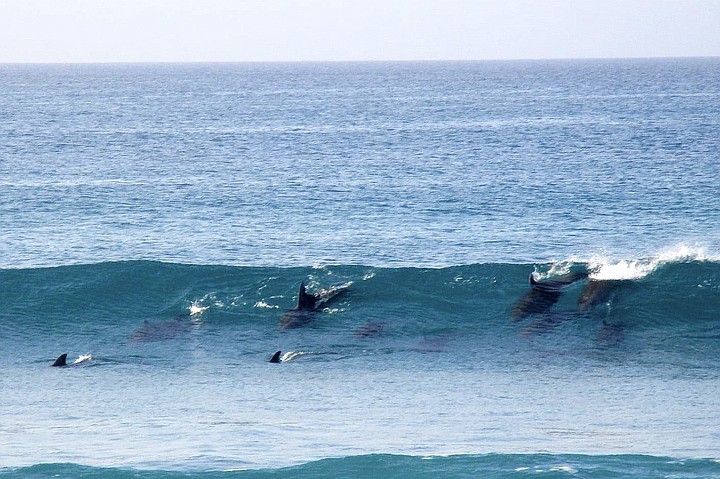Barred Surf Perch beginning to spawn
Bart Hall is in town this Week
Dock Totals 2/4 – 2/10: 208 anglers aboard 12 half-day to 3-day trips out of San Diego landings over the past week caught 14 calico bass, 1 halibut, 64 lobster (142 released), 38 perch, 62 rock crab, 242 sand bass, 89 sculpin, and 208 whitefish.
Saltwater: Rainy weather kept most of the boats in their slips this past week, resulting in what is probably my lowest total anglers, trips, and fish caught for any week since beginning the fish report nearly ten years ago. That said, catching hasn’t been the issue when folks do get out, as there are plenty of sand bass and whitefish biting for the half-day anglers. The rain seemed to turn on the bugs, too, as hoop-netters have been reporting solid limits of spiny lobsters between the fronts.
The storms coming down the line from the northwest reached halfway down the Baja peninsula, muddying up roads while putting a crimp in the fishing plans for anglers from Ensenada to Bahia de Los Angeles. As low-pressure systems drew wind up from the south, the usual Baja winter norteño winds abated and anglers on the southern half of the peninsula enjoyed calm conditions and great fishing in both the Pacific and the Sea of Cortez.
Yellowtail has been the main target inshore in most locales, including Mulege and Loreto on the Sea of Cortez and from Bahia Asuncion to La Bocana on the Pacific side; while dorado, roosterfish, and sierra mackerel have been biting well from La Paz and around to the Los Cabos area. The long-range fleet running trips of 12 to 22 days has been doing very well on larger yellowfin tuna offshore down near the Ridge and banks outside of Bahia Magdelena, and though the wahoo bite has slowed, a few skinnies are still coming over the rail.
Closer to home and along the beaches, surf perch are beginning to go into their spawning mode and are biting very well on bait and plastics. Average size is increasing as the larger females fatten up to meet the high demand of giving birth to live fry. Where many fish lay eggs, barred surf perch are viviparous, often birthing their young when stressed during the fight when hooked. Females loaded with young perch tend to be obvious in their girth, and though it is a good idea to release pregnant fish, those that have a low chance of survival due to a swallowed hook or other injury can often be kept while releasing the fry. If the fish has not given birth by the time it is landed, anglers may be able to “force” birth by pushing their fingertip gently into the birth canal. The baby perch will come flooding out if they’re close to being ready.
Barred surfperch primarily feed on sand crabs, shrimps, smelt embryos, anchovies, and sand worms. Though commercial gill netters work beaches in Mexico setting and pulling nets by hand, there is no commercial fishery for them in San Diego. The barred surfperch population has not been studied, but catch totals indicate they are healthy, and fishing for them has improved over the past two decades, especially during the El Niño and La Niña years. From 2015 through 2017, barred surf perch ranked as the number one retained species of recreationally caught fish from shore in California. (The recreational limit for barred surf perch is ten fish per angler per day.)
Given the El Niño-ish conditions so far this winter, it should be a very good season going forward for anglers pounding the sand in search of perch. Though perch are a year-round fishery here in Southern California and northern Baja, February through October is more active, with June usually being the best month. Surf perch make decent table fare, most often gutted, scaled, and fried whole until the skin is crispy brown. Their filets also work well in ceviche, though the meat can be a bit too soft and flaky for batter frying. Though humans do eat quite a few, surf perch are preyed upon by a wide variety of other predators as well, including bass, halibut, leopard shark, bonito, rockfish, seals, otters, herons, loons, osprey, cormorants, terns, gulls, and dolphin. Though dolphins are intelligent and playful, when we see them “surfing,” it is more often a predatory method than recreation. By riding the larger set waves, dolphins — often working in a group — can surprise perch, croaker, and corbina that are feeding in the roiling surf as waves break. I have seen pods of up to a dozen dolphin surf-hunting in the waves, and while it is exciting, fishing generally shuts down while they are around.

As we are in the off season for much of the fleet, trade events are in full swing. The Bart Hall Show will be at the Del Mar Fairgrounds this Thursday through Sunday. Billed as “San Diego’s Biggest Fishing Show, Biggest Boat Show, Biggest Outdoor Recreation event of the year,” the event will feature knot tying demos, fly-fishing demos, kid’s casting contests, and four stages with presentations and seminars on all aspects of fishing and outdoor recreation. There will be acres of fishing tackle vendors, rod and reel manufacturers, boats, kayaks, RVs and more. Tickets can be purchased for $17 at the gate, or online at www.HallShows.com. Kids 15 and under are free. They’re out there, so go get ‘em!